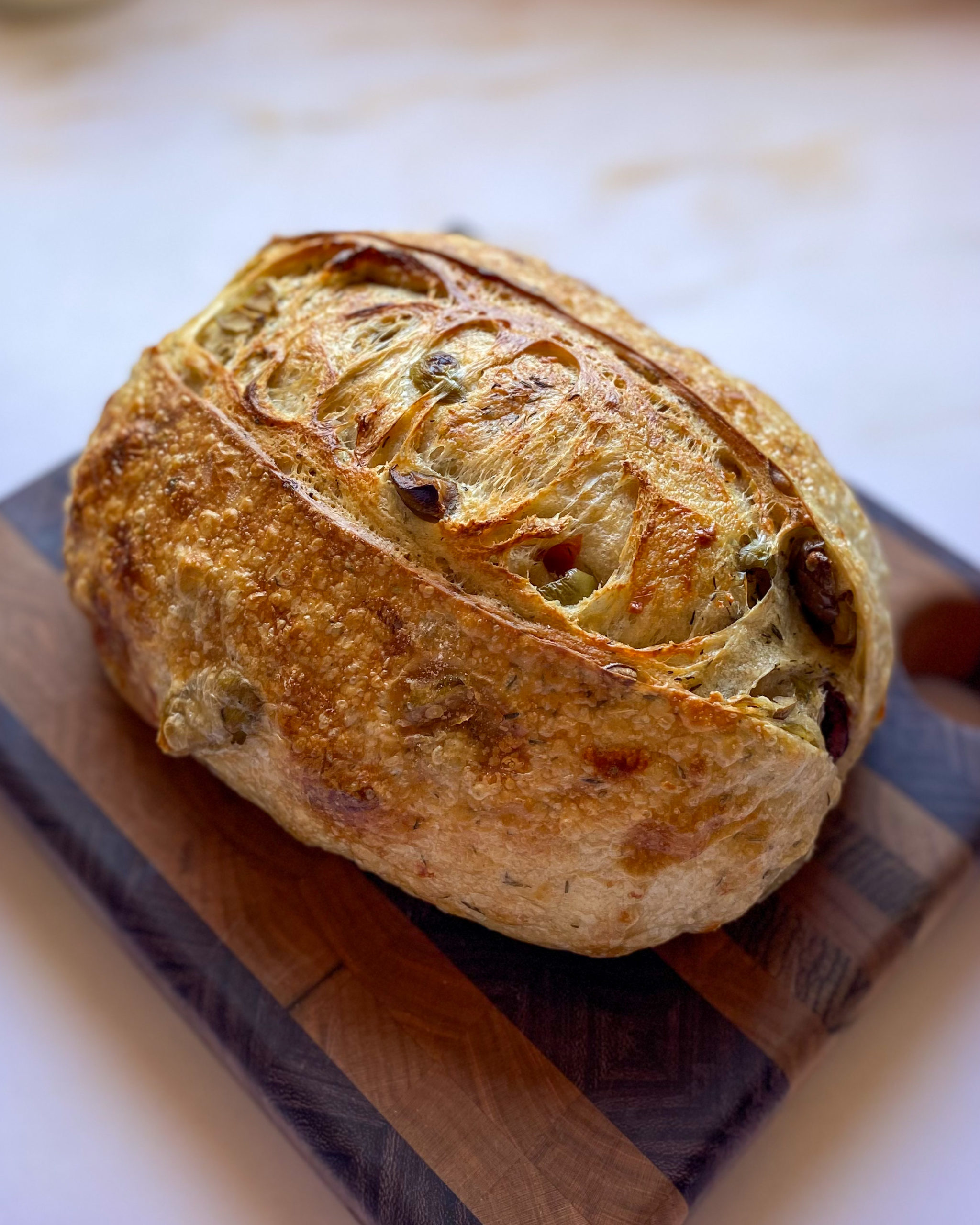With a tender crumb, every bite of this sourdough bread loaf with Parmesan cheese, Spanish olives, aromatic thyme, and bright lemon zest is loaded with flavor.
This bread is perfect to pair with other Mediterranean classics like Andalusian Salmorejo.
Olive Sourdough Bread Ingredients
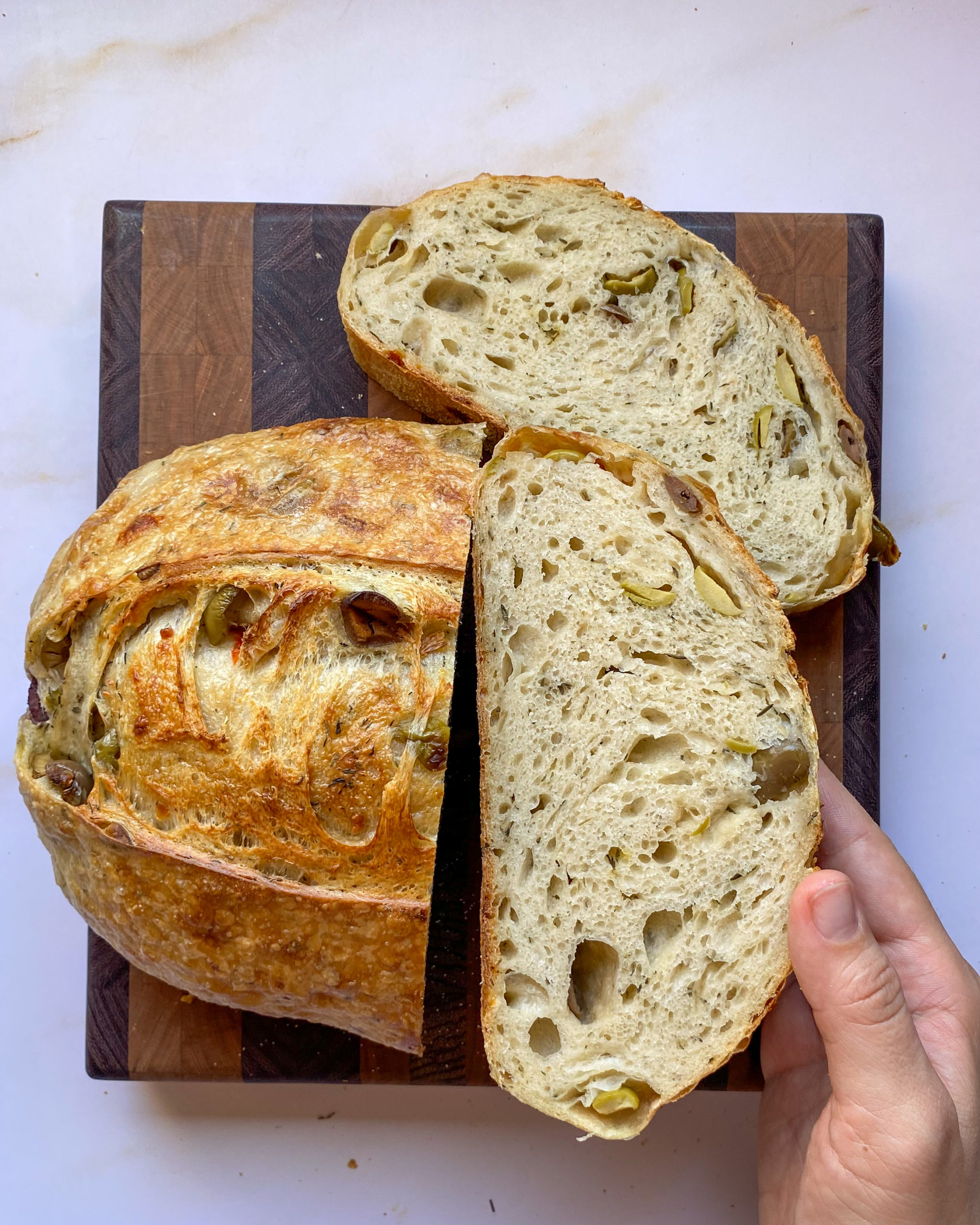
For the dough, you’ll need the following ingredients:
- Bread Flour: Any bread flour with a protein content above 10 will work just fine.
- Finely ground durum wheat flour, semolina, or semolina rimacinata: This helps to add flavor to the dough, you can leave it out or swap in another flour like all purpose or whole wheat. Tip: if you live in Spain you can find this as trigo duro or some millers sell semolina rimacinata.
- Sourdough starter: For this recipe, you will use your sourdough starter to create a levain which is mixed using the exact amount of flour needed for this recipe.
- Extra Virgin Olive Oil: I almost exclusively use high-quality extra virgin olive oil in my recipes as I live in Spain and it is easy to find here, but you can also swap in another oil of choice.
- Water: Whatever water you would have no problem drinking, whether it be from the faucet/sink, filtered, or bottled.
- Salt: Any finer grain salt will be fine to more easily mix in (don’t use coarse salt).
For the add-ins, you’ll need the following:
- Lemon Zest: From 1 medium-sized lemon to brighten up the flavors of the other ingredients.
- Parmesan Cheese or Grana Padano: I usually buy a wedge of Parmesan or Grana padano and shred it myself. Make sure to use shredded and not finely grated Parmesan cheese.
- Thyme: Dried thyme that you have on your spice rack works perfectly fine in this recipe, but fresh thyme may provide even more flavor.
- Olives: See notes below
Which Olives Should I Use?
I use Spanish manzanilla, verdiales, or hojiblanca because I live in Spain and before using them in the recipe I make sure to remove the pits. However, you can also use Kalamata olives, Castelvetrano olives, or any other favorite olive.
Tip: Wherever possible, use fresh olives with the pit still inside because they will carry more flavor rather than canned versions, just make sure to remove the pits and chop the olives before using.
Why Do You Add Oil To The Bread?
The oil works to coat the flour and inhibits the gluten network, which makes for a softer, tighter crumb and softer crust.
I also think that it adds a nice touch of flavor to the dough, just like in my Sourdough Bread with Orange-infused Oil.
How to Add Ingredients to Sourdough Bread?
While there are plenty of ways to add ingredients to bread, In my opinion, one of the best ways to include add-ins is with a process called lamination.
What is Lamination? And How to Do It
Lamination in baking refers to stretching the bread dough out to later fold it back together in layers. This helps to create structure within the bread and is also a great way to evenly spread out any add-ins to the bread.
While this is my preferred method for adding ingredients, if you do not have the space in your home kitchen, you can simply replace this step with another stretch and fold adding in the ingredients with each turn.
Step 1
Place the dough on a clean surface. Make sure to wet the counter lightly so that it does not stick
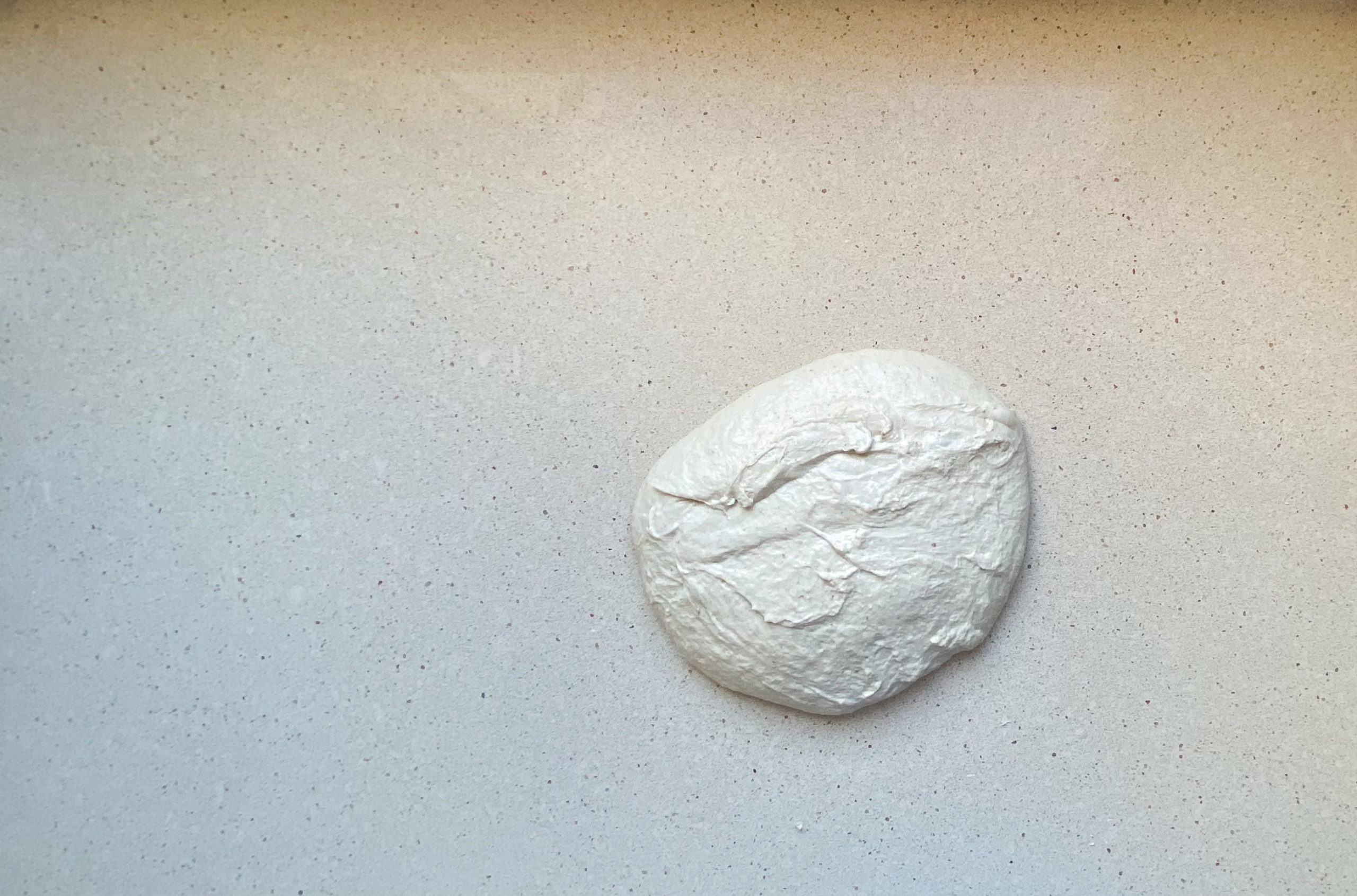
Step 2
Now, with wet hands gently lift the edges of the dough and pull from the middle to evenly spread the dough out into a large rectangle shape. To avoid tearing, move slowly, move from the middle outward, and make sure your hands are wet.
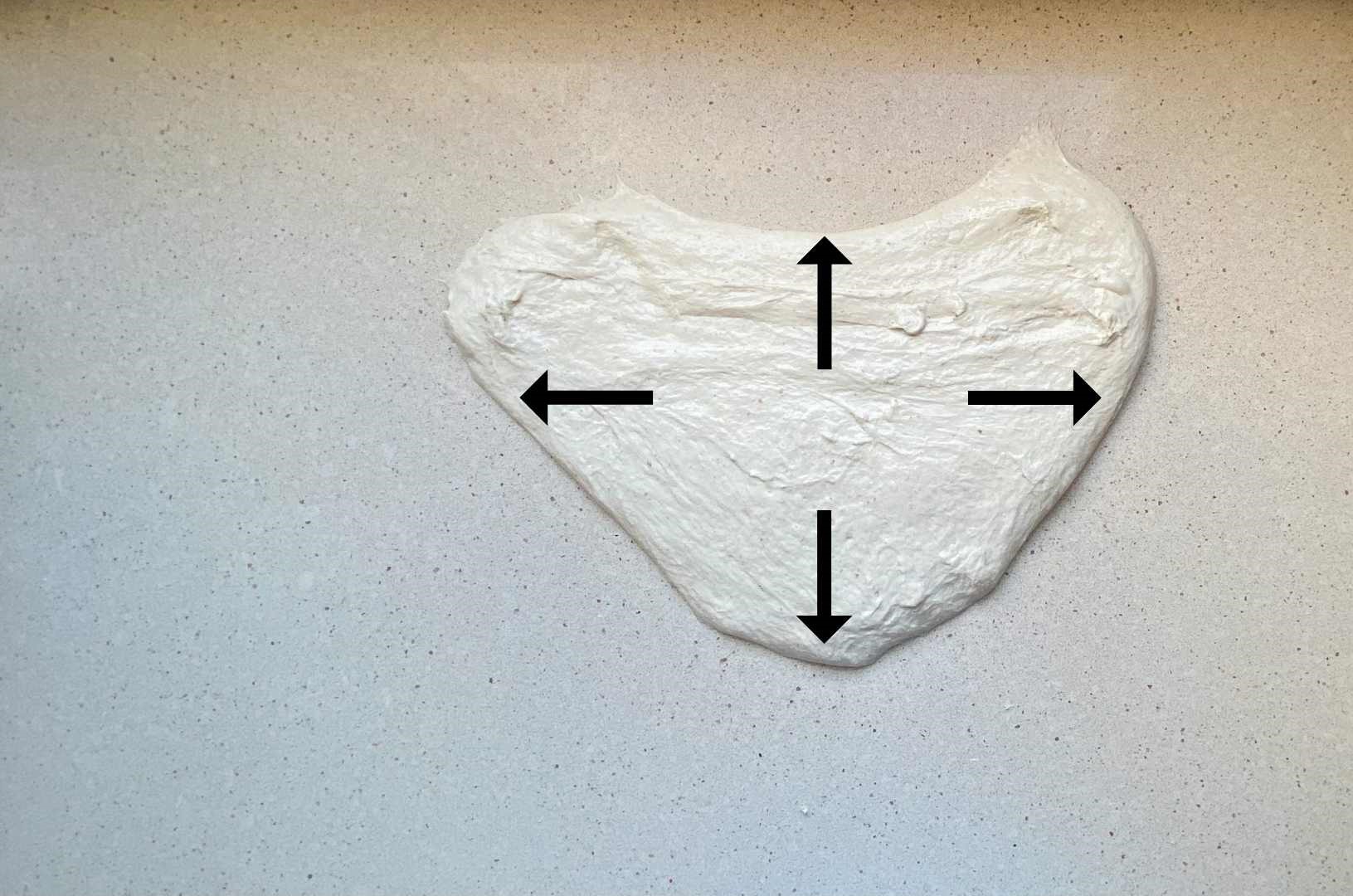
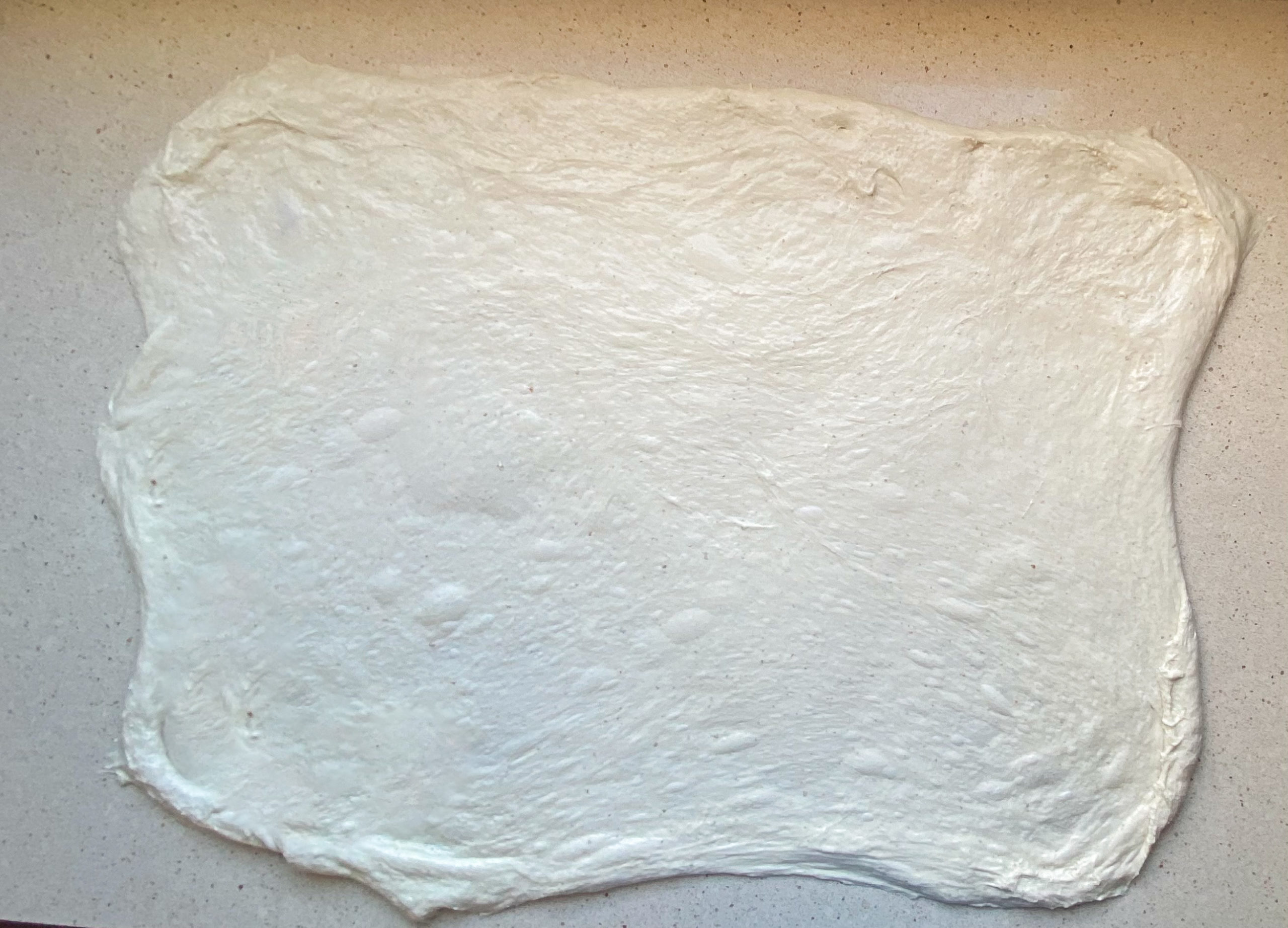
Step 3
Once your dough is evenly spread out into a large rectangle, now is the time to add in about 90% of your ingredients. Save the last 10% of your ingredients for a step later on.
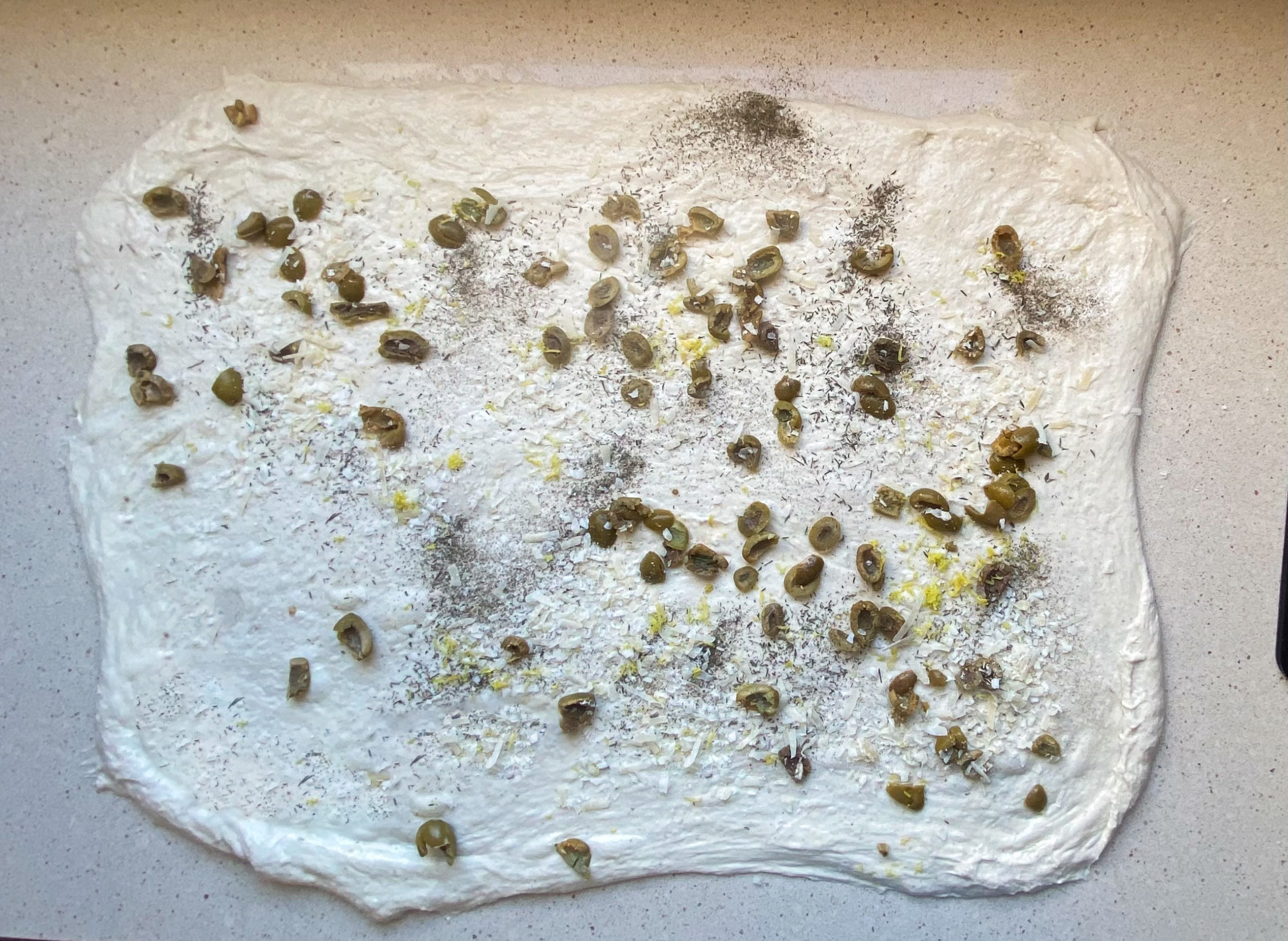
Step 4
Once the ingredients are added in, it is time to laminate the dough into layers. First, start with the right-hand side. Gently release the edges of the dough from the surface with wet hands and pull it into the middle, ensuring that you will be folding in thirds.
If it begins to tear at any point in this process, do not worry, just continue the best you can layering your dough.
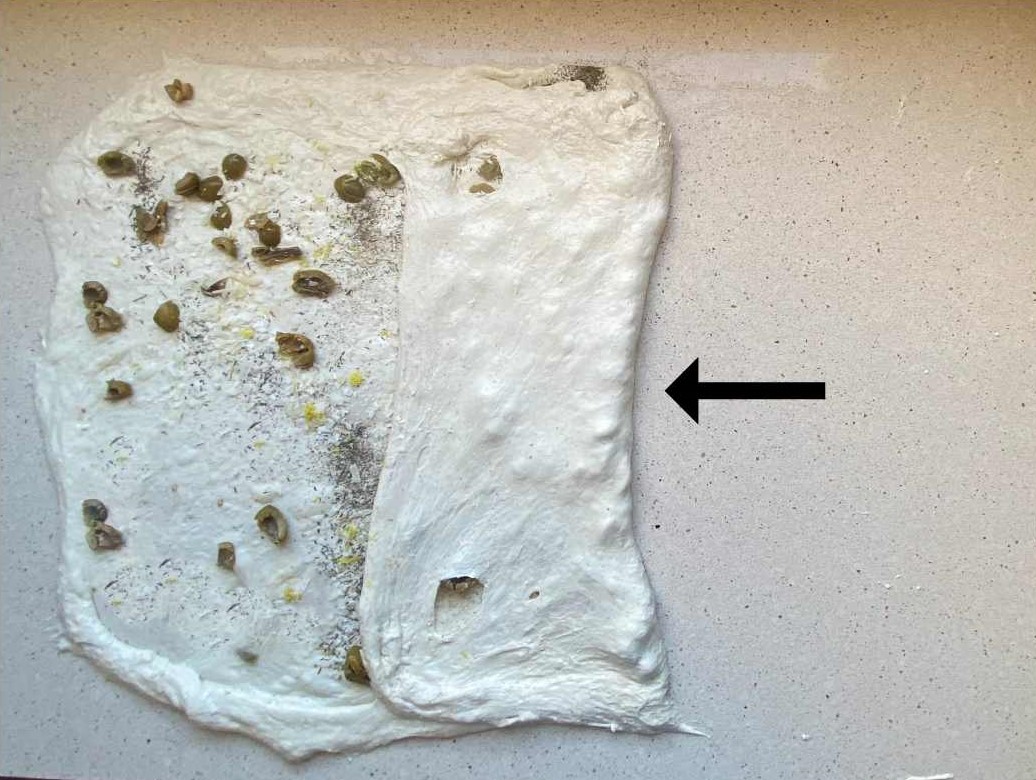
Step 5
Once the right side is folded into the middle, gently release the edges of the left side and pull it into the middle covering the right side.
Here is where I like to add in the last 10% of the ingredients.

Step 6
Now, pull the top down into the middle.
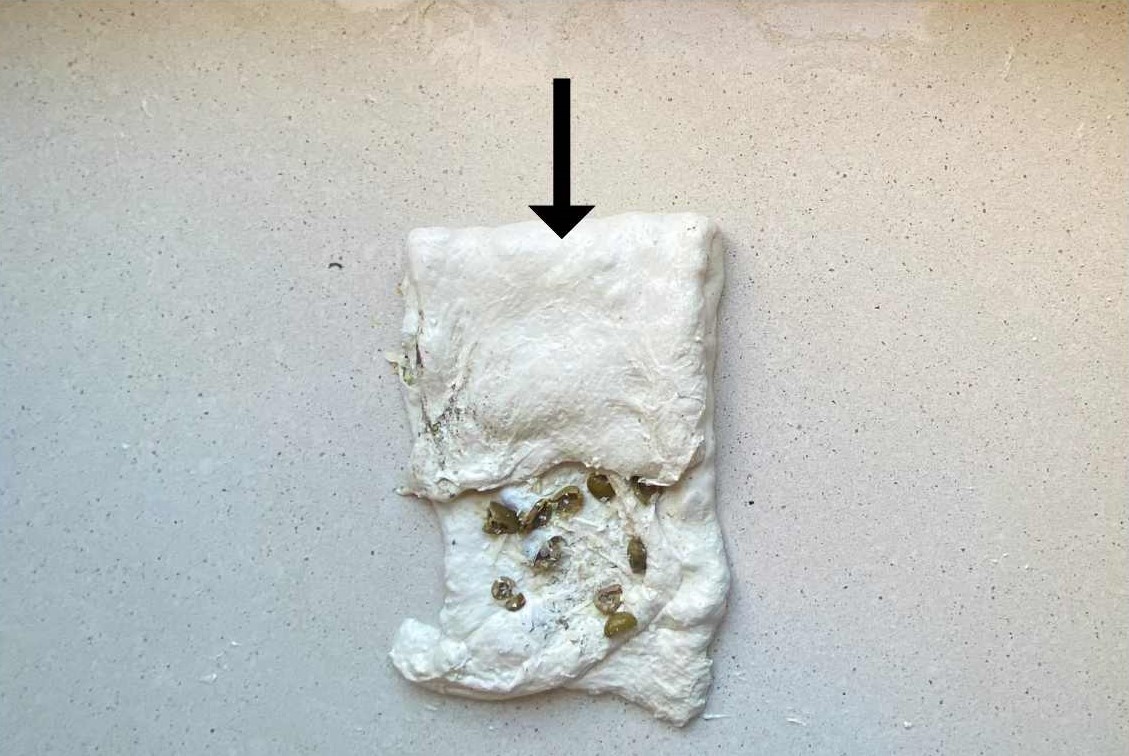
Step 7
For the final fold, pull the bottom up into the middle covering the top layer.
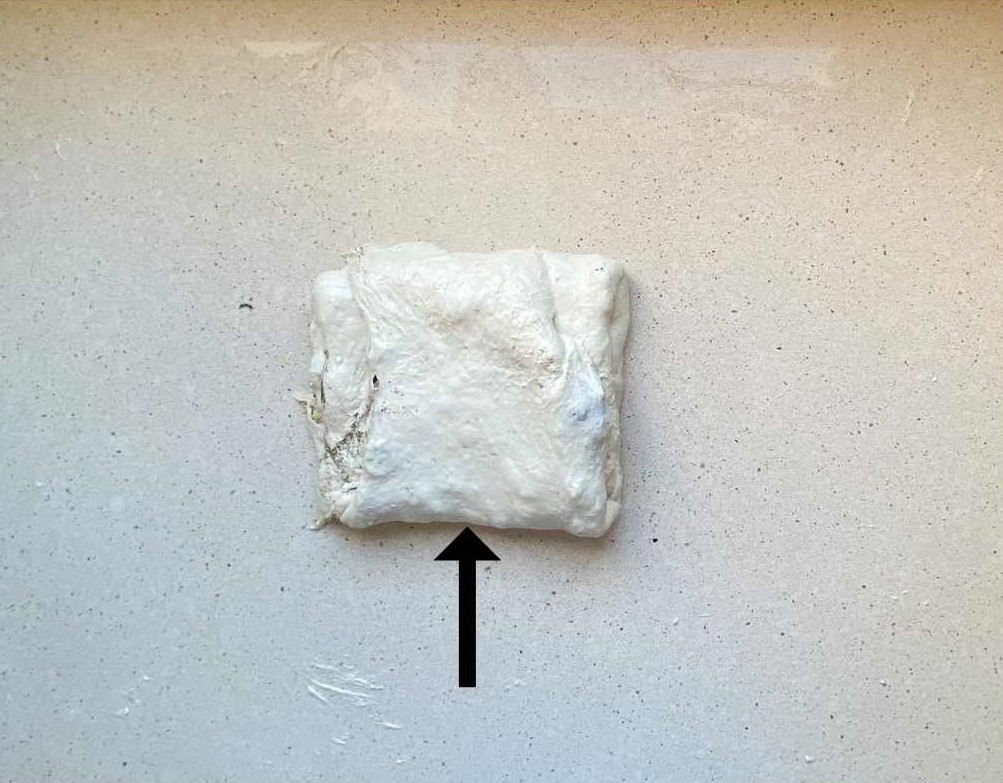
Step 8
Gently lift it from the middle and place it into a bowl, or another container, to finish bulk fermentation. Lifting it from the middle, let the top and bottom edges hit the bowl first and fold the middle over the top.

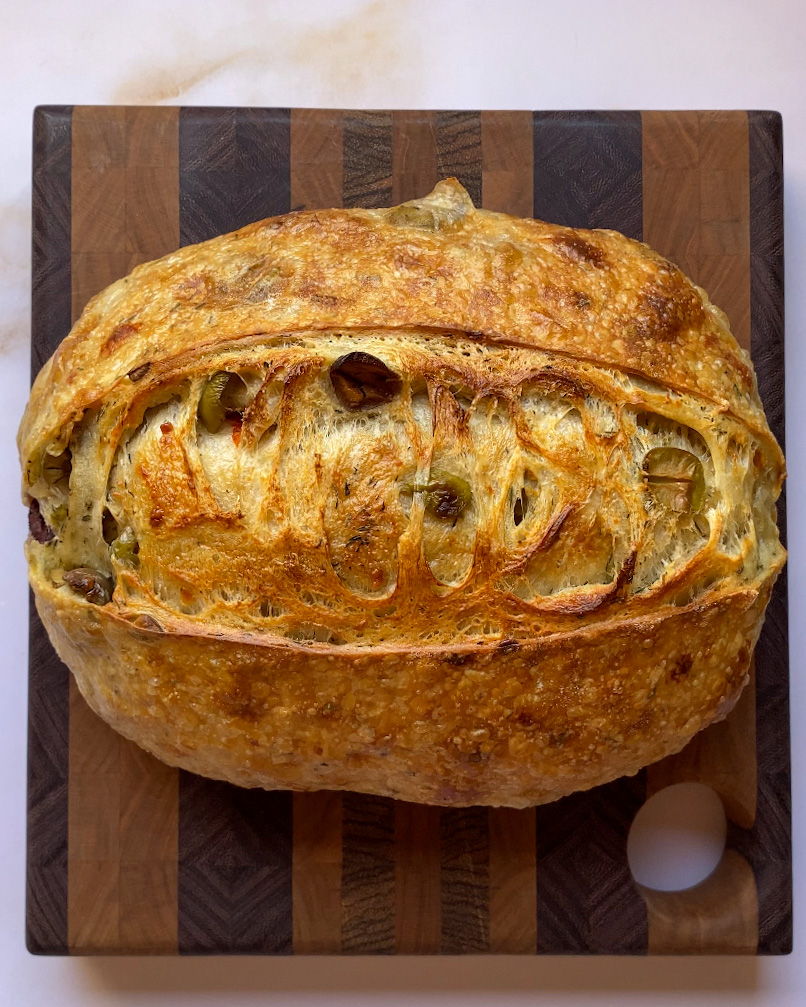
Parmesan and Olive Sourdough Bread
Ingredients
For Sourdough Levain
- 20 g Sourdough Starter
- 45 g Bread flour
- 45 g Water
For Bread
- 380 g Water
- 12 g Extra virgin olive oil
- 100 g Sourdough levain
- 450 g Bread flour
- 50 g Durum wheat, semolina, or All purpose flour
- 9 g Salt
- 140 g Olives (chopped, pits removed)
- 2 g Thyme (2 tbsp dried)
- 40 g Parmesan cheese or Grana Padano freshly grated
- Zest from 1 lemon
Instructions
- Prepare the levain: combine your levain ingredients (20g starter, 45g bread flour and 45g water) in a bowl and transfer to a tall jar or container to track its growth easily. It is ready to use when it has doubled in size (or just about), it may take about 4-6 hours depending on its strength and external temperatures. It will have some bubbles and the texture will be like soft melted marshmallows. Temperature note: If you’ve got cold temps, leave it somewhere a bit warmer (about 25C/75F).
- Autolyse: Combine the water, oil, and sourdough levain together in a large bowl. Then, add both flours and mix until no bits of dry flour remain. Cover your bowl (with a lid, wet towel, plastic wrap, etc.) and let that sit in a warm place (about 25C/75F) for 1 hour.
- Add in Salt: After an hour, sprinkle the salt over the top of your loaf. Dimple and pinch to mix it in until it is all incorporated. Cover your bowl and set it for 30 minutes in a warm place (about 25C/75F).
- Strengthen the dough: After 30 minutes, give the dough 1 set of stretch and folds. To do this, with wet hands grab one side of the dough and pull it gently to the other side. Rotate the bowl 180 degrees and do the same. Repeat another 180 degrees 2 more times until the dough is back around 360 degrees.
- Lamination and ingredient add-in: This recipe uses lamination to include the ingredients (lemon zest, thyme, olives, and shredded cheese). See my guide to lamination with photos above the recipe.
- Bulk Fermentation: Once all of the ingredients are included in the dough through lamination, place the dough back into the bowl and cover for 30 minutes. After 30 minutes, perform 1 coil fold to help give your dough structure and help to further develop the gluten. Then, cover and let your dough sit until it is finished fermenting.
- Notes: Fermentation starts when the levain is added to the dough. For this bread recipe, the dough usually ferments well in 5 hours of fermentation with a consistent dough temperature of 78F/26C. I measure with a dough thermometer, however if you don’t have one, you can place the dough in a larger straight-sided vessel after the ingredients have been included. When the dough rises about 25% of its initial size, it should be done.
- Pre-shape: Pre-shaping helps to give your dough even more structure and a bit of tension. If I am making just one loaf, my preferred method is to give the dough one last coil fold in the bowl and let it sit again covered for about 20 minutes. You can also do this on the counter. Wet the counter with a spray bottle or just drop water down. Turn it out of the bowl onto the counter and fold the outside into the middle and form it into a ball.
- Final Shape: Dry off your counter space and sprinkle a bit of flour down to prevent sticking. Fold your dough and place in your banneton. Here you have two options, you can leave it to proof or you can let it sit and proof in the refrigerator to let the flavors develop even more.
- Note: leaving it in the fridge also makes it easier to score and helps it to have more oven spring. If you choose to leave it in the fridge, you can leave it anywhere from 2 to 48 hours.
- Bake: Preheat the oven 30 minutes, with the dutch oven inside, at 250C. Once the oven is hot enough, take the dough out of the fridge, turn it out onto parchment paper and give the dough a slice on the top (score) and place it in the dutch oven. Bake for 20 minutes with the lid on, then take the lid off to release the steam and get your crust crispy for 15 minutes and reduce the temp to 225C. Then take it out of the dutch oven, and place it alone on the rack for 15 minutes at 180C.The dough is finished cooking when the internal temperature reaches 95C/190-200F. Important: After taking it out of the oven, make sure to let your dough sit for at least 30 minutes to reduce a gummy interior.

